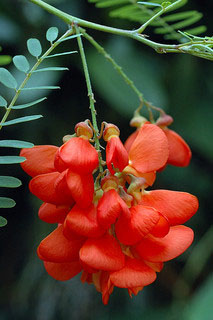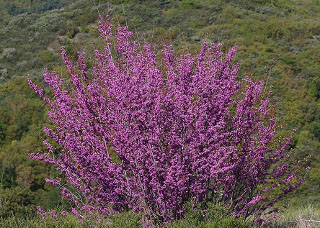 Sesbania punicea. Photo by Eric Hunt (cc).
Sesbania punicea. Photo by Eric Hunt (cc).
Red sesbania (Sesbania punicea), also known as Scarlet wisteria or rattlebrush, is a deciduous shrub or small tree in the pea family that is rapidly expanding its range in northern California, specifically in the Sacramento region. Red sesbania was brought to California as an ornamental plant, probably because of its long-lasting red to orange pea-like flowers. Red sesbania has escaped cultivation and is becoming established along California's rivers and other waterways.
Red sesbania plants usually become reproductive when they are two to three years old and can produce 100 to 1000 seed pods per year, which each contain five to ten seeds. Seed pods can fall into waterways and travel downstream where they establish new populations, allowing this plant to spread rapidly along streams and rivers. Once established, red sesbania can form dense stands that cut off access to rivers and streams, choke out native vegetation needed by wildlife, and can lead to erosion and possibly flooding. Red sesbania plants also contain chemicals called saponins that are poisonous to humans, livestock, and wildlife when eaten.
Despite all of the negative consequences of escaped red sesbania plants, California nurseries continue to sell them, and the expansion of red sesbania in California is expected to continue. Faced with this threat, it is important that California gardeners do their part by not planting red sesbania in their gardens, but instead use alternatives that provide the same function.
Native Alternative
 Cercis occidentalis. Photo by David Hofmann (CC).
Cercis occidentalis. Photo by David Hofmann (CC).
Western redbud (Cercis occidentalis)
Like red sesbania, western redbud is also a shrub or small tree in the pea family that drops its leaves in the wintertime. Unlike red sesbania, however, western redbud is native to California, and will not damage the environment if it escapes from your yard. Western redbud can grow to heights of about 7 to 20 feet, similar to red sesbania, and contains multiple trunks from the base, which can be cut back if the appearance of a small tree is desired. Western redbud has beautiful pink flowers that can attract an abundance of pollinators during the spring months. The leaves change from green in the summer, to yellow and red in autumn, and in winter the rust-red seed pods remain on the stems after the leaves have dropped. Western redbud stems are valued by Native Americans for basket weaving, who cut back the stems to create straight new branches. Western redbud is easy to grow and requires little maintenance; it prefers partial to full sun, requires little water, and although adaptable, prefers well-drained soils. Like red sesbania, Western redbud grows well along streams, but unlike red sesbania, it is a good soil stabilizer and beneficial to waterways.
Western redbud is a great alternative to the invasive red sesbania because it provides similar beauty and utility in your garden, but without the potental negative impacts on wildlife and habitat. Try this native alternative in your garden!